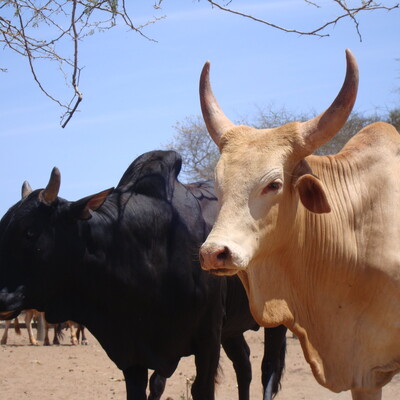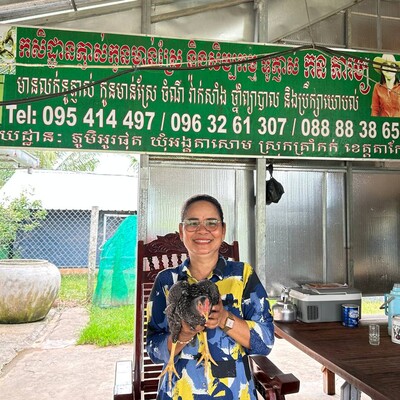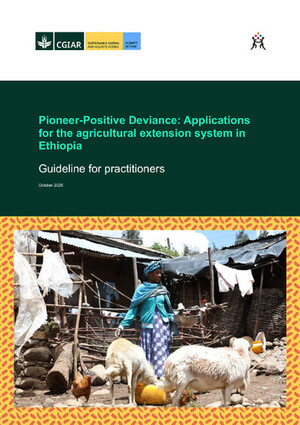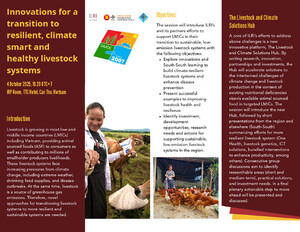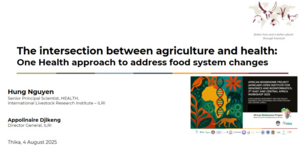
Index-based livestock insurance: Reflecting on success
One of the International Livestock Research Institute’s (ILRI’s) major success stories in recent years has been the development of an index-based livestock insurance program (IBLI), which protects livestock keepers in drought-prone arid and semi-arid lands from climate-related losses. The program began in Kenya, has been extended into Ethiopia, and is under consideration in several other east African countries. Unlike traditional insurance programs, which pay out on the loss of the animal, IBLI is tied to climatic conditions such as the amount of rainfall and distribution of pasture availability over a season. By tying the payouts to objective criteria, the program avoids the moral hazards of traditional insurance programs while giving herders the resources to help their animals survive periods of sustained crises.
Recently four authors associated with the program published an article in the journal Outlook on Agriculture, where they recounted the challenges they faced establishing the program and discussed some of the lessons they learned. CKM writer David Aronson recently spoke to two of the authors of that article, Rupsha Banerjee of ILRI and Andrew Hall of Australia’s Commonwealth Scientific and Industrial Research Organisation, to find out more about how the program came about. ILRI’s head of Communications and Knowledge Management, Michael Victor, also participated in the conversation.
David: You begin the article by observing that the research excellence of the CGIAR centers hasn’t always translated into meaningful, on-the-ground impact, but that IBLI was different. So I guess the first question is simply, What made IBLI different? What made it so successful not just theoretically but practically?
Rupsha: I think one of the things that made IBLI different was the approach. From the very beginning the vision was that this would be a financial service, an insurance product, and not just a research project. And secondly, we designed it for the pastoral areas and the dry lands where that kind of product had never been attempted, unlike intensive crop areas. And third, we had the idea that this would be an insurance product designed by an international research organization but that ultimately it would be taken over and given to the private sector to be operationalized. The project team really went out of the way to defy certain odds and build in a strong implementation component along with the research component. And then of course the leadership here at ILRI, which decided to push the envelope, and to negotiate and to keep talking to the donors on this project, even though it was very different from the sort of thing ILRI has done in the past.
‘Research organizations have traditionally worked on a model where we invent things in our laboratories. And then we chuck those technologies over the wall, and hope that they find suitable homes.’
Andy: Can I present that in a slightly different way Rupsha? To polarize the story to make the point, research organizations have traditionally worked on a model where we invent things in our laboratories. And then we chuck those technologies over the wall, and hope that they find suitable homes. And that often does happen in cases where you’ve got a well-developed private sector which can act as a delivery mechanism and has the capability to deliver the technology. It happens in a setting where you’ve got a policy environment which provides incentives for people to adopt it and for the private sector to deliver it. And it works in an environment where farmers have the capability and interest to adopt the technology and get benefits from it.
Now the case of IBLI, all of those preconditions were missing. So while the research developed a very interesting product, to actually get from research into practical use, IBLI, and ILRI more generally, have to engage in building the capacity of the private sector, of popularizing the technology with the pastoralists, and really in forming policy about the potential benefits of this sort of insurance scheme, and therefore ultimately getting policy support from it. So I think, and this Rupsha’s point, that it was this combination of doing a really solid bit of science, and then coupling that up with things that people would normally think about as development interventions and capacity building. And you know the real part of the IBLI story is how they managed to connect these two worlds of high-end science and developing the technology and unblocking problems that arose during implementation.
David: And it sounds like you, in your capacity as scientists, had to go well outside your comfort zone in order to accomplish this.
Rupsha: Yes. Right. For example, one of the things that took us out of the comfort zone was when it came to promoting the product. That was not in our original mandate, even by a long shot. So it was a surprise when we realized that we had actually overestimated the capacity of the private sector. We conducted an evaluation study, about six months before the product was going to be launched, that specifically said that ILRI’s role would be to design the product and to provide technical support. And the marketing and publicity side would be purely and squarely the role of the private sector.
Andy: The irony is that because of the nature of the team, they were actually quite comfortable with this need to engage with development processes to make value out of their science. I think the sticking points or discomforts came from concern over the legitimacy of doing that within the organizational setting of an international research center, which is supposed to be focused more on science than development. And then the other discomfort was about the confidence of the donors to trust that a science agency could do something that had a very development feel to it. So I think that the discomfort was probably not within the team so much as beyond it, from pre-conceptions about what a research organization could or should do.
David: Let me follow up on that. One of the things that surprised me is that there wasn’t initially greater interest on the part of the private insurance companies. I’m used to thinking that market forces step right in when there’s an opportunity for a buck to be made. And yet you describe the insurance companies as being relatively hesitant and lacking in the sort of entrepreneurial wherewithal to really take advantage of this opportunity. Could you talk about that a little bit, and about what challenges that posed for you?
Rupsha: When the product was designed, there was a lot of interest from the private sector, and that made us confident that this was going to be a market mediated product, helmed by commercial partners. And when the first sales window came, just before the long rain, there was a lot of hype and a lot of fun about launching this product. And the first window sales were incredible, like we got nearly 2,000 sales. But then in the second round, we didn’t have that kind of success. What the private sector very soon realized is that that this was not a typical insurance product. There had to be a lot of explaining and promoting it to the pastoralists, which they couldn’t do sitting in their office. They needed to go to the field, and they needed to talk one-on-one with people. That’s when the interest started going down and a lot of insurance companies dropped off in this period.
So eventually in order to make sure that the product continued, ILRI entered into a contractual agreement with one of the insurance companies, on the condition that it was to be an exclusive contract. That wasn’t an easy decision: It went against the principle of the entire organizational scheme of things as far as the international research organization is concerned. But it was the only way to proceed, as the insurance companies started to understand what a tall order it was to get the product out there.
Andy: There’s an assumption that there’s a vibrant private sector out there that’s willing and incentivized to service the needs of poor households in marginal areas. And that turns out to be quite clearly a myth. And that’s one of the big findings from this work, that building the capacity of the private sector is critically important. Assumptions about their ability to deliver are probably overoptimistic. And so there’s a need not only for capacity building, but for policy support to help them do it. That’s a pretty big and important observation.
David: You also talk in the article about the cultural or policy changes within ILRI that made this possible. Could you talk a little bit about those and about how you were able to overcome the constraints within ILRI to make these sort of leaps forward.
‘One of the reasons why this was possible was because of the vision and the leadership of the team leader, Andrew Mude.’
Rupsha: As far as IBLI is concerned, I think one of the reasons why this was possible was because of the vision and the leadership of the team leader, Andrew Mude. And not only him, but also the team in general, who shared a vision that this particular market-driven intervention needed to get out there to the people, in a proper and systematic manner. And built into the project was a process of iteration, so that if something went wrong, you needed to go back to the drawing board, you needed to have discussions, and then you needed to find a solution that would work for everyone. So one of the cultures of IBLI has been that we go on a lot of soul-searching meetings. Not just retreats every two years, but a lot of reflective thinking and workshops.
Another thing was the risk and the courage that the team leader had to develop and question ideas freely, to push against structures and mandates that might have limited us. For example, I mentioned the ambivalence we felt about the exclusivity of the contract. As much as we knew that we needed an insurance company on our side, giving an exclusive contract was not something we had envisioned. But we made the decision to go ahead, because we were committed to the project and it fit within our mandate of developing an international public good.
And a third thing was that we engaged in constant conversations with the management, donors, the private sector and our partners. It was this whole concerted effort to make sure that nobody was left out. We didn’t just inform people, ‘Oh by the way’. Negotiations and discussions were happening at every point in time.
Andy: I just want to pick up on three points, which Rupsha you covered in different ways. I think the leadership that Andrew Mude provided, and the sort of people he selected for his team, were critical. He had the leadership and vision to create a culture within that team which was about impact and making a difference in pastoralist communities. The second was the wider cultural acceptance of this type of hybrid research and development program. And I think there were two reasons for that acceptance. One, it had a plausible success story that was evidenced by impact information. Here was something that was tangibly working. And because of that it could attract streams of funding. And I think that gave the legitimacy within the organization for the team to do the sorts of things they were doing, which were certainly at the margins of practice at that time.
Michael: Just getting back to some of the institutional issues. I find interesting that you recommend that we shouldn’t be setting up centers within centers or own little units. IBLI has done very well for the reason that you said, because of its leadership and vision, because there was passion about it, and because it was in its own bubble. But there are hundreds of potential IBLIs all around the CGIAR system, and many of those bubbles never land back on the mother ship. So what are the implications for doing innovation, for having impact at scale?
Andy: I think it’s a really interesting observation. And the point that we make in the paper, which is a sort of slightly barbed critique of some of the other CG Centers, is that development centers have been set up to try and tackle the impact conundrum. But that’s often being done without a clear interface back into the core science agenda of the organization. What’s missing is the ability of the organizations and the system as a whole to stand back and reflect on that and say, “Actually we’ve got something here that’s an approach which promises to increase the likelihood of impact of our science agenda as a whole,” and institutionalize that as a legitimate way of working. And so we have these islands of interesting stuff, but no mechanism for critically reflecting on that and bringing those ideas into the mainstream.
David: Following up on Michael’s question, toward the end of the article you say, look, the success of IBLI can’t be mechanically replicated and used elsewhere, but there are perhaps some general lessons that can be drawn. And I think Michael’s alluded to one very important one, which is that it’s not just about setting up and institutionalizing some new program or initiative. What other lessons can be drawn?
‘In my opinion, the phrase ‘research for development’ has been used very loosely’.
Rupsha: Let me speak more from the operational, and Andy you can speak more from the research perspective. One of the trajectories that ILRI and now the CG centers are embarked on, is a very strong emphasis on the research for development paradigm. But in my opinion, the phrase ‘research for development’ has been used very loosely. And we should really think much more carefully about what research for development is. That means that you think at the outset about capacity development, about having the development component enmeshed as part of research. And you build that into the monitoring and evaluation of the project and into the learning system. So having a strong emphasis on processes is a very critical factor and one of the lessons that can be taken.
And another one is not focusing over-much on best practices, which I think is a highly over-rated concept. It is more useful to look at what lessons can be drawn from different methods and what are the lessons that can be fed back into improving the system. Maybe some emphasis should also be given on failures, as in not just see things from the ‘success story point of view’. It could be that the project did not pick up, but there were certain things that we learned and that can be used. So I think for me those would be the biggest takeaways.
‘How do you think of programs as both research and development? How do you integrate innovation and impact into your science programs?’
Andy: One of the big lessons around this is the artificial-ness of the distinction between research activity and development activity. And IBLI is a very good case in point about how managing these two things in a constructive and interlocked way adds value to your science and adds value to your impact. Now the lessons that emanate from that are manifold. One, we still have a fairly siloed set of funding opportunities which are either research on the one hand or development on the other hand, which means that it’s actually quite difficult to run projects which successfully bridge these two things. The second lesson that comes out of out of IBLI, and it comes out of a lot of things that we’ve looked at, is this idea that there’s a distinction between the research phase and the implementation phase. This turns out to be entirely false. And that comes back to Michael’s point: You don’t set it up as a separate organizational entity, you build it into the research programs themselves. And that’s a pretty hard lesson. How do you think of programs as both research and development? How do you integrate innovation and impact into your science programs? If you’ve got the answer to that, you probably deserve a Nobel Prize, because it’s very difficult.
Read the article: Emerging research practice for impact in the CGIAR: The case of Index-Based Livestock Insurance (IBLI) – https://doi.org/10.1177/0030727019866840
For a presentation on how IBLI is helping build resilience among pastoralists in Ethiopia, see here.
For a video presentation on why women are among the best clients for livestock insurance in East Africa, see here.
And for a more comprehensive series of articles about IBLI, see here.
Download recent reports and publications from the project.








